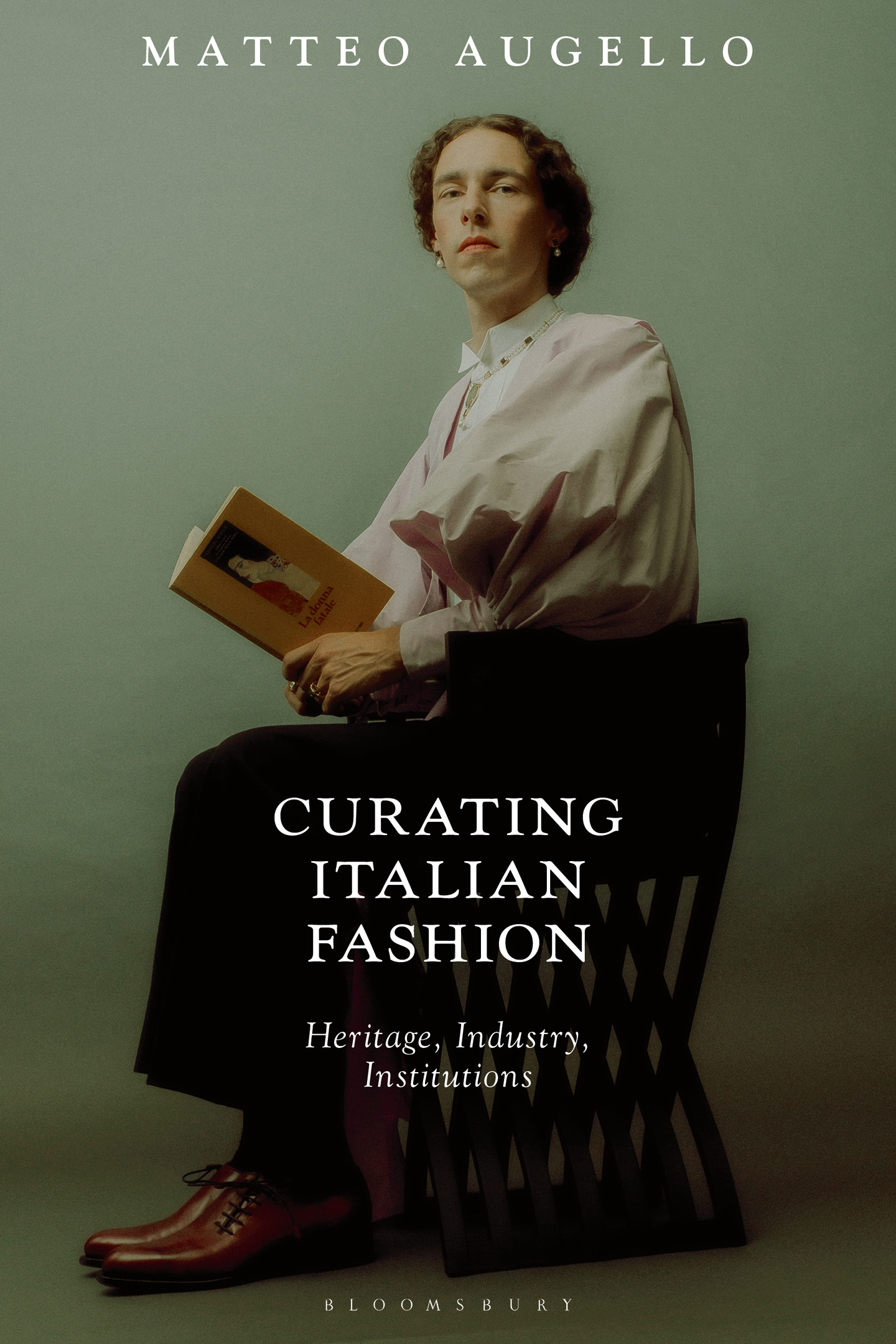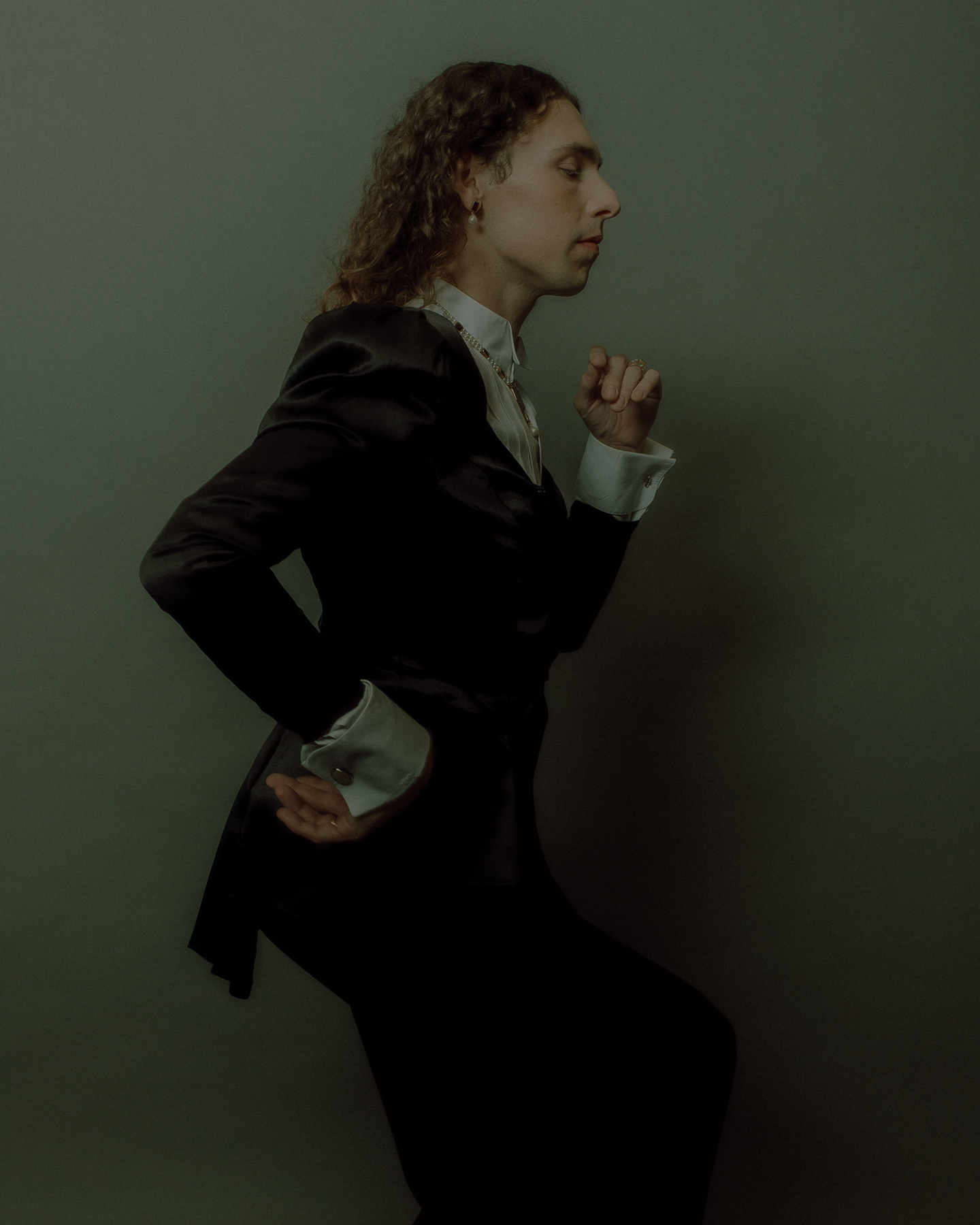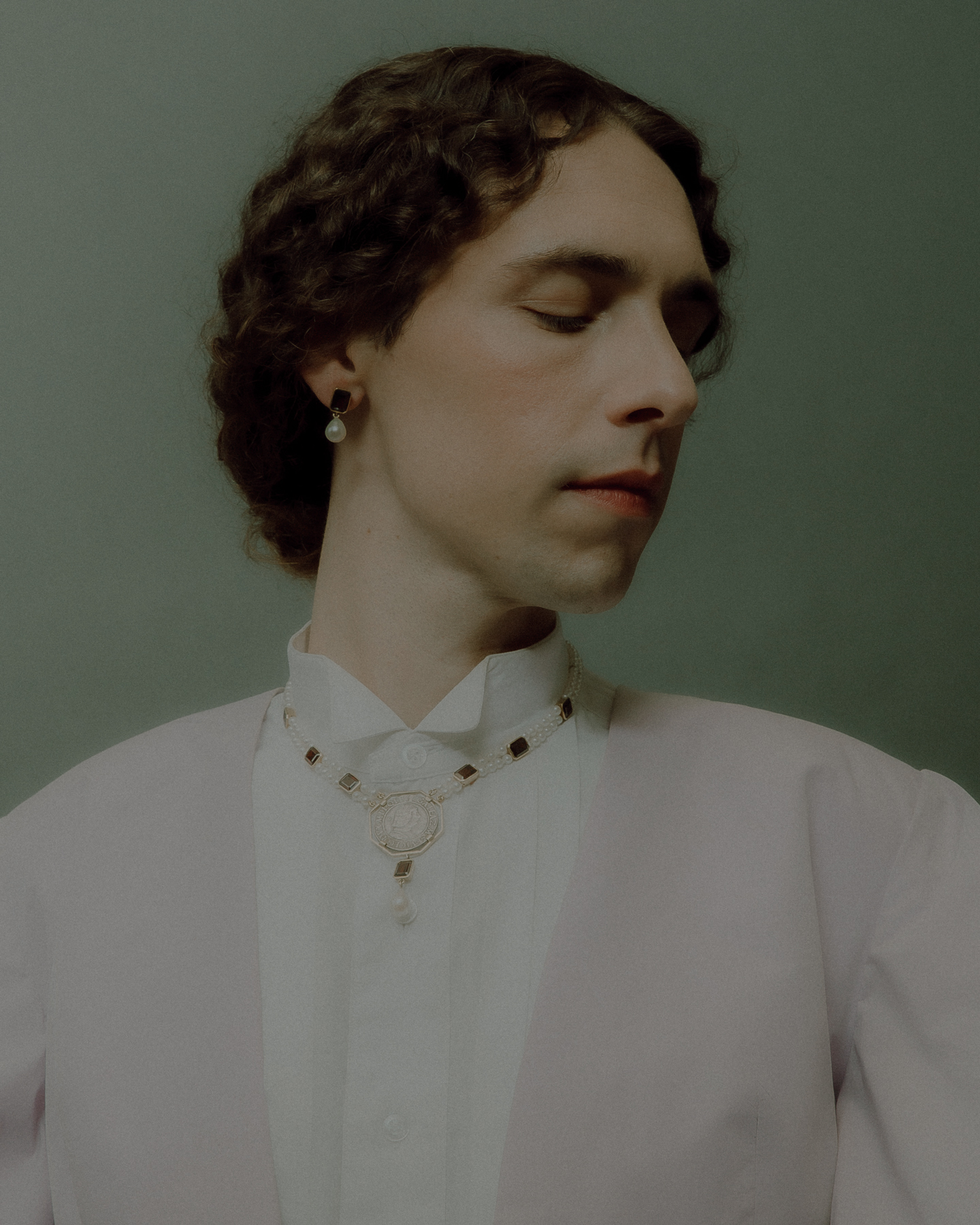

While you can easily find tons of books on Italian luxury houses and the designers who have shaped the global fashion scene, what do we know about the development of fashion curating in Italy? Hardly anything, until now. Performer and lecturer in Fashion Heritage and Research Methods at Istituto Marangoni London, author Matteo Augello has just launched his book Curating Italian Fashion. Heritage, Industry, Institutions, published by Bloomsbury (2022).
Book cover of Matteo Augello’s Curating Italian Fashion. Heritage, Industry, Institutions, published by Bloomsbury (2022). Photo courtesy of Daniele Fummo. All photographic material featured in this piece was taken at Istituto Marangoni London
As little has been previously written about Italy’s contribution to fashion curation, this volume stands as a significant study. Over his three years of PhD research, Matteo Augello framed the history of Italy’s economy, culture and historical-artistic tradition, contextualising all this within the management, display and curation of the Italian fashion heritage.
But what makes Curating Italian Fashion unique as a whole, is the particular focus on the role played by the companies and industry associations. The book unfolds the ties between the preservation of fashion heritage and corporate policies, thus demonstrating that commercial interests underlying fashion curation can coexist with the scholarly contribution of corporate initiatives. Tracing the shift of companies from sponsors to cultural producers, Augello’s research proves that such a curatorial approach, defined by the involvement of the fashion industry, has created a unique practice in the Italian scenario.
Organically structured into six chapters, Matteo Augello’s Curating Italian Fashion draws on archival records, existing literature and oral history. We, therefore, interviewed Matteo Augello about his research journey to find out how to overcome the challenges of such a complex investigation into Italian fashion heritage. Read the author as he shares his academic knowledge and interpretation of an ever-evolving topic.
Matteo, how would you introduce your book Curating Italian Fashion to readers?
This book is an introduction to how Italian fashion has been constructed through exhibitions, particularly on the importance of heritage in building and establishing the identity of a national fashion or an idea of national fashion. I think Chapter one – 1. Constructing Italian fashion heritage – in particular can be of interest to a broader audience because it focuses on how the Renaissance was used for marketing the arts and heritage. For Masters students, it could be a useful read if they’re interested in exhibitions or fashion and heritage marketing.
“My book is an introduction to how Italian fashion has been constructed through exhibitions, particularly on the importance of heritage in constructing and establishing the identity of a national fashion or an idea of national fashion” – Matteo Augello, author of the book Curating Italian Fashion and lecturer at Istituto Marangoni London
For academics, primary research is essential to collect data directly to validate the research project. Which was your starting point of research?
Well, I had two. It started from passion, really. There’s no way you could do research without enjoying it and loving it. In terms of how I used primary sources, I collated many, many, many resources. It also started with observing: my first job was as an intern researcher, and then I continued working in the field. Through my work, I started noticing unique aspects of Italian fashion and curation, so I started reviewing secondary sources, and there were a lot of them. Those then became my primary sources because I was analysing not Italian fashion but how people have talked about Italian fashion. And so those books, introduction to catalogues, etc., were my primary sources. Some catalogues were made by an Italian association of textile historians (CISST) in the 1980s and 1990s, and I could access them thanks to those scholars allowing me in their personal libraries. I was going through these people’s lives rather than in archives. In terms of industry, I was interested in who funded companies and framed the definition of the corporate culture in Italy due to the absence of support from the State. I knew I didn’t have access to it and wouldn’t get access to sensitive corporate information.
Matteo Augello’s portrait. Photo courtesy of Daniele Fummo
Through the research, what was the discovery that came out?
As I started reading between the lines of catalogues and especially the forewords of sponsors, I realised that there was always a very transparent way of discussing the exchanges between industry and scholarship.
“Research is not a matter of opinion: it is about the rigour with which you engage with evidence to support an argument” – Matteo Augello
Why were you concerned about getting involved in the discourse of fashion corporate heritage?
I had to differentiate myself as a scholar and a visitor to exhibitions. The PhD helped me learn how to manage that subjectivity more. I had to analyse exhibitions that I was not particularly impressed by as a visitor but which, nevertheless, are an essential part of Italian fashion curation. Research is not a matter of opinion: it is about the rigour with which you engage with evidence to support an argument.
Matteo Augello’s portrait. Photo courtesy of Daniele Fummo
How did you organise the chapters of your book Curating Italian Fashion based on your research?
I would say that chapters one, two and three mostly rely on secondary sources. These are chapters through which I’m establishing the foundations of the 1. Constructing Italian Fashion Heritage; 2. Industry and corporate heritage in Italy, and 3. Corporate Heritage and Institutions. I’m pulling all threads together from what has been researched so far. The first chapter focuses on the construction of the Italian fashion heritage. I had to make this point to explain why exhibitions, which are tools for heritage management and communication, were extensively used for that purpose from the very beginning.
After this foundation section, you moved on to the heart of the book, which is Fashion Curation. How did you manage that?
Chapter 4 – A history of fashion curation in Italy – is what I’m most proud of. It is a reconstruction of the evolution of curation in Italy, even though not every exhibition is mentioned. It took a long time to put all this together and divide it into sections, and I am presenting an overview of the complexity. I mainly engaged with secondary sources, and by organising this history, I developed my interpretation of fashion curation in Italy. It was necessary to understand the industry’s role in this practice.
As you pointed out, the emphasis placed on the major arts in Italy meant that companies themselves had to take care of their heritage, leading to the birth of corporate archives and corporate museums or institutions. As a result, they have developed strategies that combine marketing and cultural production. What does this mean?
I realised the Italian circumstances from living in this country (the UK). I think it’s a misunderstanding, or rather, it’s a misconception that corporates are biased and public institutions aren’t. Hopefully, that is the main message of my book or one of the main ones. In Italy, museums have engaged with the industry and have been clear and transparent about their limitations in ways that I find refreshing.
“In Italy, museums have engaged with the industry and have been clear and transparent about their limitations in ways that I find refreshing” – Matteo Augello
In the last chapter of your Curating Italian Fashion, you referred to the Museo Salvatore Ferragamo in Florence, created from their corporate archive. How did this museum tackle the challenge of curating fashion?
I talk a lot about the Museo Salvatore Ferragamo. I think they are a good, very good model. They have understood the way to balance corporate needs with scholarship and intellectual freedom (from Chapter 5, Industry and Curation: A critical commentary). They went through different phases: at the beginning, it was a temporary exhibition. Then it became a permanent display based on that retrospective exhibition, and later they started looking at different aspects of the founder’s life. A single focus on a brand or creative figure is challenging for a museum. The director of Museo Ferragamo, Stefania Ricci, is scholarly trained. She understood the importance of having an institution of the brand that manages its historical archive but also maintains the flexibility required when you are part of a living brand. You can draw the relevance of Ferragamo not only in Salvatore Ferragamo but in the links of the many narratives in which you can inscribe a biography. It’s really like thinking of films, you look at the story of someone, but it resonates with many because it touches on universal themes.
“Museo Salvatore Ferragamo in Florence is a very good model. They have understood the way to balance corporate needs with scholarship and intellectual freedom” – Matteo Augello
Matteo Augello concluded the final chapter with a question: what is Italian about fashion curation? In his book Curating Italian Fashion, he attempts to answer this question by outlining the relationship between heritage, industry and institutions in the complex system intrinsic to Italian society and culture. He proposes an interesting interpretation of the cultural operation companies could adopt by engaging visitors as customers, but to discover more about this, we let you read the book.
A final note: The cover of the book Curating Italian Fashion portrays author Matteo Augello as a tribute to the tradition of Italian Renaissance portraiture. Augello made a visual reference to an Italian artist, Giovan Battista Moroni, with a photoshoot in which he posed in style while holding the book La donna fatale by Grazietta Butazzi, one of Italy’s most important post-war historians of costume and fashion. The photoshoot for the cover image resulted from the collaboration of a team of Italian creatives and was taken at Istituto Marangoni London.
Augello, M. (2022) Curating Italian Fashion: Heritage, Industry, Institutions. Bloomsbury Publishing can be found in the Istituto Marangoni London Library and is available for purchase from Bloomsbury.
Silvia De Vecchi
University Librarian, London





